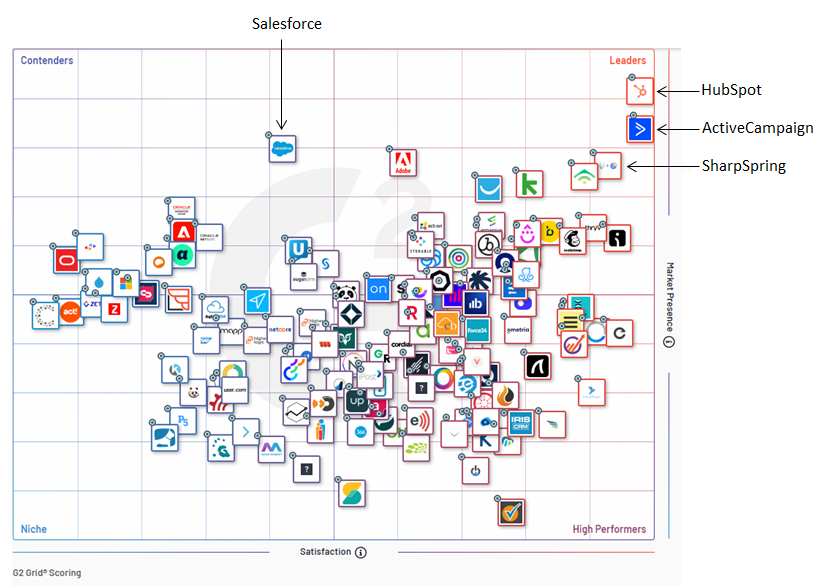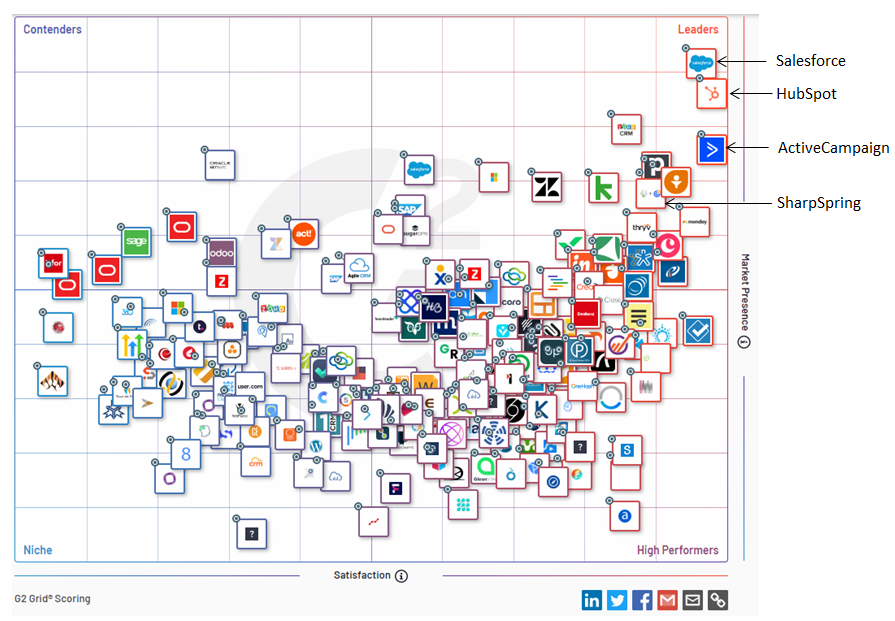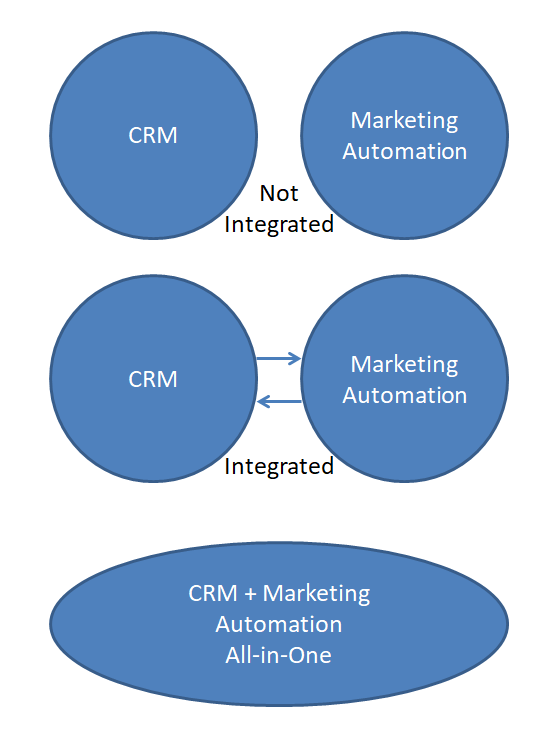
We believe that every B2B company needs a CRM and a marketing automation system. Ideally, these would come in a single package (and database) from one vendor. Examples of companies that sell combined CRM and marketing automation systems are:
- HubSpot
- SharpSpring
- ActiveCampaign
Coincidentally or not, these three companies are the top three rated Marketing Automation systems, according to G2. See their chart below:

Salesforce, the number one CRM company, acquired Pardot in 2013 and moved it into their Sales Cloud in 2018. Architecturally, Salesforce CRM and Pardot are still two separate applications that are integrated. This was done so they could continue to be sold separately. However, since one company is developing both applications and is responsible for the integration, it’s pretty close to a single application.
If we take a look at the top CRM systems, according to G2, we see some of the same companies that topped the Marketing Automation grid:
- HubSpot
- SharpSpring
- ActiveCampaign
But at the very top of the list, to no surprise, is Salesforce.

We have met many companies that have CRM and marketing automation systems from separate vendors. For example, they may have Salesforce for CRM and HubSpot for marketing automation. Or Salesforce and Marketo. In most cases, the sales leader at the company selected the CRM system and the marketing leader selected the marketing automation system. And it seems like each department leader made their selection without consulting the other department. That’s too bad.
Why? Because if they had collaborated on the decisions, they might have realized that there are numerous advantages to purchasing a combined CRM and marketing automation solution. Here are some of the advantages.
No integration to configure or manage (or break)
If you design the system from the ground up to have both marketing and sales functionality in a single database, there’s no need for integration. You don’t have a contact record in CRM and another contact record in marketing automation. There’s just one shared contact record. This may not sound like a big deal, but it is. It’s a small component that makes all of your processes less painful by saving you a lot of time.
Having a single shared file for contacts and company data makes things MUCH easier. It means no data getting out-of-sync. No wondering which record is right.
As soon as you have two files with company data (one for sales, one for marketing) the data gets out-of-sync. Maybe the sales file has a two letter abbreviation for states and the marketing system uses the full state name. Maybe one system stores the contact name as one field, but the other system stores it in two fields (first name, last name). Maybe one system has a field for the contact’s LinkedIn profile, but the other system doesn’t.
All of these minor differences have to be handled by the integration software. And rules need to be made. Which system is the master? If the data is different, which system is right?
Shared Data Leads to Pleasant Surprises
Once marketing and sales are sharing the same contact file, all sorts of pleasant surprises start to happen. Every engagement by the prospect is tracked in the contact record by the marketing automation system. That means webpage views. Email opens and clicks. Form fills. Downloads. Advertising clicks. This is data that a good marketing automation system tracks. Now the sales team gets to see it.
And it’s not just the sales team that benefits. Marketing can now see sales activities in the contact record. Let’s say that a contact opened and clicked an email, then downloaded a white paper. The sales rep saw this activity and called the prospect. Their notes about that call can inform what marketing does next. For example, if after speaking with the prospect, the sales rep opened a new opportunity, the contact lead status field can be moved from LEAD to OPPORTUNITY. And this could trigger an ABM advertising campaign. All of this can be more easily automated by marketing automation since it’s one system.
You might be wondering, wouldn’t we get all of this if we integrated CRM with marketing automation? The answer is: that depends. Some companies opt for light-weight integration and don’t send this type of engagement data over to CRM. They opt to simply sync basic contact and company fields. Or they get the integration provided by the CRM or marketing automation company and that integration doesn’t include engagement data.
Our Recommendations regarding CRM and Marketing Integration
Here are our recommendations regarding CRM and marketing automation software integration:
- If at all possible, buy a single system that includes both CRM and marketing automation. This means no integration is required. Trust us, you’ll be happy you did so.
- If a single system isn’t in the cards, then get two systems that come with a well-designed, well-supported integration. An example of this is the Salesforce-HubSpot integration built and supported by HubSpot.
- If an integration isn’t available for your CRM and marketing automation systems, look for a 3rd-party integration. If that’s not available, then hire a company that specializes in building integrations, with extensive experience integrating your CRM brand to your marketing automation brand. This is not a job for your IT team.

You may be wondering: can an all-in-one solution, such as HubSpot, meet both our needs for CRM and marketing automation? Will our sales team be settling for less? In our experience, most sales teams leverage a fraction of the capabilities of most CRM systems. HubSpot is a powerful solution that is more than capable of meeting and exceeding their needs. And in our experience, sales teams enjoy using HubSpot. We often hear things like “we like the UI better” and “it’s easier to use.”
Thinking about CRM and marketing systems integration? We’re happy to discuss your situation and provide some guidance. Click this link to schedule some time with us.
Full disclosure: We are partners with HubSpot and SharpSpring. However, we have clients who use Salesforce, Eloqua, Pardot, Marketo, HubSpot, SharpSpring, AutoPilot, Sugar CRM, Pipedrive, and other solutions. We have years of hands-on, daily experience with these systems. Our point of view is shaped by this experience rather than our partnerships.